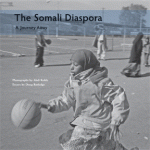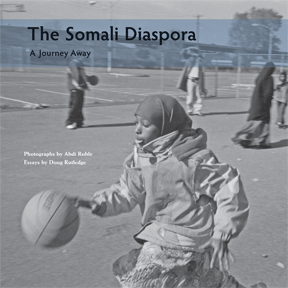
In black and white photographs, award-winning documentary photographer Abdi Roble chronicles the lives of Somalis from the refugee camps in Kenya, to their new homes in different parts of the world. A picture, as the saying goes, tells a thousand words.
The Somali Diaspora: A Journey Away by Abdi Roble and Doug Rutledge does exactly this, and perhaps much more. Roble and Rutledge, of the Somali Diaspora Project, combine their talents to share the realities, histories, and dreams of Somalis from a wide range of experiences. From the refugee camp to resettlement – they capture the presence and impact of a people whose country remains torn by 18 years of unremitting violence. Their complete work attempts to fill a void by historians and mass media.
Minneapolis community organizer Hashi Abdi is credited for giving the book its structure, which divides the phases Somali immigrant life into three experiences. The first is dependence, reflecting the refugee camp experience. This period is followed by preparation, as lived in many American cities. The final phase is participation – a phase best illustrated by Somalis in Minnesota. This community challenged the notion that active participation entails assimilation, and while the Diaspora elsewhere continues to prepare, they maintain that Somalis in Minnesota are fully engaged.
At the height of the Somali Civil War documentarian Ali Said’s home was looted and destroyed taking with it the history of Somalis through the lens of the country’s only photographer. Said’s loss gave purpose to the book and the project.
And so begins Rutledge and Roble’s extensive documentation of one of the largest Diaspora communities in America.
Their exploration of Somali movement begins at a place familiar to almost all refugees – the camps in Kenya. We are taken to Dabaab, a place the author describes as “that dry, hungry place.”
In Dabaab we meet the family of Abdisalaam and follow them to Anaheim, CA. Photographs of Ijabo, Abdisalaam wife and mother of three toddlers, are hauntingly haggard. She is decidedly malnourished because while at the camp she fed her share of cornmeal to the family’s goats, so that the goats would produce milks for her children to drink.
When Abdisalaam, Ijabo and their children finally resettle in Anaheim Roble captures their anxiety, culture shock and their joy as they begin to make a new home.
Rutledge describes the hardships those in the camp experience, and Roble’s images encapsulate these accounts.
In Columbus, Roble photographs Somali vocalist Maryam Mursal as she performs at a wedding. Mursal, who is known for literally walking her way from the civil war, is a powerful figure in the Somali community. The fusion of Somali and American culture is captured with an image of a wedding where the bride is clad in a white gown while women behind her are wearing the Somali dirac, flowing gowns.
Like many immigrants before them Somali refugees face cultural and societal challenges in their sometimes unwelcoming new home. With his camera Roble delves into the friction that grew between Somali and African Americans in Columbus forcing some Somalis to flee one apartment complex.
Thanks to a sponsorship from the McKnight Foundation and Arts Midwest Roble and Rutledge, on a four-month trip, finally take the last phase of the Somali Diaspora project to Minnesota. In their words, “Minneapolis was like dessert somehow, the sweet after a challenging holiday meal.”
The scope of Roble and Rutledge’s work in Minnesota is vast. From community and business leaders to healthcare and education professionals Minnesota is home to diverse professions.
Nimco Ahmed, a young woman has engaged her community in local and national politics; Hussein Samatar is a business leader in the Somali and larger African community; Omar Abdulle, a comedian uses humor to “mitigate the frustration of a community trying to adjust to a foreign culture”; and Hassan Mohamed Jamici who teaches at William Mitchell College of Law is a scholar in the community.
Other professionals featured include a dentist, a female bus driver, doctor, student and several activists.
The social and political accomplishments of this community is celebrated in the piece, including the election victory of Keith Ellison and the establishment of charter schools reflecting East African cultures.
If you have driven around the Cedar-Riverside area in Minneapolis you will recognize Roble’s photographs of the Brian Coyle Center: images of Somali women clad in the hijab, Somali men in kanzus.
Perhaps you have visited Karmel Mall in Minneapolis, a Somali shopping center, which houses boutiques, restaurants, money-transfer bureaus, barber shops among other small businesses.
Roble’s compilation truly attempts to do justice to the diverse community it covers, representing both marginal and majority sub-populations within the Somali community. Roble and Rutledge’s powerful collaboration exists as a meaningful historical account for a community struggling to collect itself from a devastating civil war. But above all, the piece expresses tremendous hope in, and for, the Somali Diaspora in Minnesota and elsewhere.
The work of award-winning phtographer, Abdi Roble, will be displayed at the Weisman Art Museum from June 20 – September 13, 2009.
The Somali Diaspora: A Journey Away
By Abdi Roble and Doug Rutledge
176pages. University of Minnesota Press
$35
About Ramla Bile
Ramla Bile is based in Minneapolis and is a general assignment reporter. She graduated from the University of Minnesota and is a former editorial board member of the Minnesota Daily and a producer for the KFAI collaborative project, Muslims in Minnesota.







